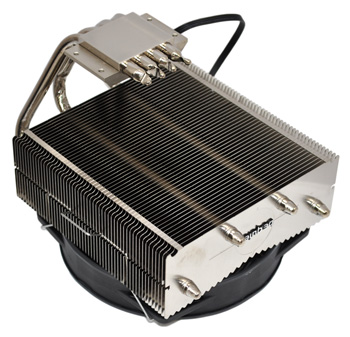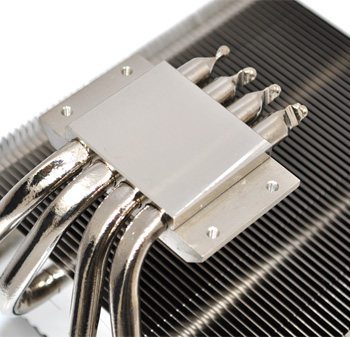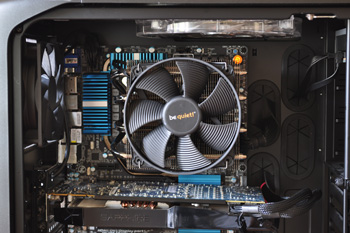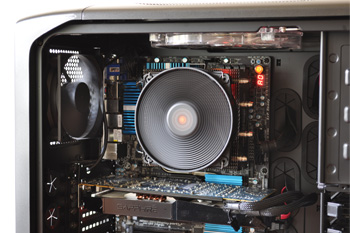Getting Up and Running
Taking a closer look at the cooler's unusual orientation sheds light on how it will transfer heat away from the CPU. It starts with a super-smooth, machined and nickel-plated copper base that's connected to four c-shape heatpipes, each measuring 8mm in diameter. The four heatpipes then pass through 53 serrated aluminium fins, upon which sits a large 135mm Shadow Wings PWM fan capable of running at 1,500 RPM.
The overall fit and finish is excellent, right the way through from the way in which the fan sits snug on rubber mounts, to the clean contacts between heatpipes and base plate. We've no qualms about build quality - it's very good - but be quiet! coolers aren't usually the easiest to install and the Shadow Rock TopFlow is no exception.
It'd be a stretch to describe installation as difficult - getting the Shadow Rock TopFlow in place is certainly not as infuriating as the Dark Rock Pro 2 - but it's tricky nonetheless. In a nutshell, the backplate is attached to the rear of the motherboard using four screws, and it's then clamped in place using c-profile spacers.
The correct mounting brackets - LGA1155 in our case - are then attached to the bottom of the cooler, and, once you've applied some thermal paste, the whole thing attaches to the backplate using the four aforementioned screws. The challenges are twofold; tightening the screws from behind the motherboard while keeping the cooler held in place can be a two-man job, and there are likely to be clearance issues.
Whether we tried to mount the cooler horizontally or vertically, we found that it always managed to foul our tall G.Skill TridentX memory modules. To get the cooler installed we had to remove G.Skill's elongated heatspreaders, though, with the Shadow Rock TopFlow covering the memory entirely - as well as most of the motherboard's other vital components - cooling in this area shouldn't be a problem.
The in-chassis images above provide a better sense of scale; the Shadow Rock TopFlow may be a low-profile cooler, but it's still a monster in its own right. And it's this size that makes it look awkward. Having a black 135mm fan staring you in the face isn't our idea of attractive, but then again it is designed for slimmer desktop enclosures where you won't be looking at it head on.
Before we get to the benchmarks, we'll start by rating the Shadow Rock TopFlow on presentation, installation and aesthetics. In keeping with our recent CPU cooler reviews, each category is scored out of five and we provide an overall percentage, too.
Presentation |
Installation |
Aesthetics |
 |
 |
 |
 |
Presentation, as usual, is one of be quiet!'s strong points, but tricky installation - including memory clearance issues - and a somewhat ungainly look provide only an above-average early impression.













